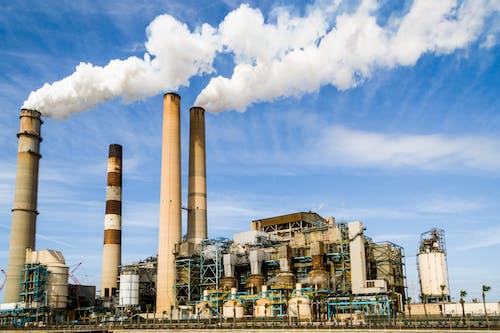Pollution poses a significant threat to our planet and its inhabitants. From contaminated air and water to overflowing landfills, the consequences of environmental degradation are far-reaching and often irreversible. To combat these challenges, two key strategies have emerged: pollution control and pollution prevention. While both aim to protect the environment, their approaches differ significantly.
Pollution Control vs. Pollution Prevention: A Proactive vs. Reactive Approach
Pollution control focuses on mitigating the harm caused by pollution after it has already been generated. It’s akin to cleaning up a spill after it’s happened. This reactive approach involves various techniques, such as:
Waste treatment: Processes like filtration, neutralization, and incineration aim to render pollutants less harmful before they are released into the environment.
Waste treatment plant
Beyond the Bucket: Stopping the Leak of Pollution at its Source
End-of-pipe solutions: These technologies, like scrubbers and catalytic converters, are installed at the source of pollution to capture and treat pollutants before they escape into the air or water.
Endofpipe solutions
Remediation: Contaminated soil and water are often treated on-site or transported to specialized facilities for cleanup.
Turning the Tide: Why We Must Prioritize Pollution Prevention
Soil remediation
While pollution control plays a crucial role in protecting the environment from existing threats, it has limitations. Treatment processes can be expensive and energy-intensive, and they often produce secondary wastes that require further management. Additionally, they don’t address the root cause of the problem – the generation of pollutants in the first place.
Pollution prevention, on the other hand, takes a proactive approach. It focuses on stopping pollution at its source, preventing it from being generated altogether. This preventive approach is often more sustainable and cost-effective in the long run. Some key pollution prevention strategies include:
From Cleanup to Closure: Embracing Pollution Prevention
Process optimization: Industrial processes can be redesigned to minimize waste generation, use less water and energy, and substitute harmful chemicals with safer alternatives.
Process optimization in a factory
Product design: Products can be designed for durability, repairability, and recyclability to reduce waste and extend their lifespan.
Products designed for recycling
Consumer education: Raising awareness about responsible consumption habits, such as reducing, reusing, and recycling, empowers individuals to contribute to pollution prevention.
Consumer education on recycling
By preventing pollution at its source, we can avoid the environmental and health impacts associated with waste treatment and remediation. Pollution prevention also conserves resources, reduces energy consumption, and promotes a more circular economy.
Choosing the Right Approach:
In many cases, both pollution control and pollution prevention are necessary to effectively address environmental challenges. The ideal approach often involves a combination of both strategies, considering factors like the specific type of pollution, cost-effectiveness, and long-term sustainability.
Here’s a helpful analogy to understand the difference:
Imagine pollution as a leaky faucet. Pollution control would be like putting a bucket under the leak to catch the dripping water. While this prevents further damage, it doesn’t fix the problem itself. Pollution prevention, on the other hand, would be like tightening the faucet to stop the leak altogether.
While pollution control remains essential for managing existing pollution, prioritizing pollution prevention offers a more sustainable and proactive solution for safeguarding our planet’s health and well-being. By embracing preventative measures and fostering a culture of environmental responsibility, we can build a cleaner and healthier future for generations to come.
Remember:
Pollution control is like cleaning up a spill after it’s happened, while pollution prevention is like stopping the spill from happening in the first place.
Both strategies are important, but pollution prevention is often more sustainable and cost-effective in the long run.
By working together, we can prevent pollution and protect our planet for future generations.
conclusion
Pollution casts a long shadow over our planet, threatening ecosystems, human health, and the very fabric of our environment. To combat this critical challenge, we must rise to the occasion with innovative solutions and a deep commitment to sustainability. While both pollution control and pollution prevention play vital roles in this endeavor, it’s time to shift our focus towards the proactive nature of prevention.
Think of it like this: imagine two paths diverging before us. One leads us down a familiar road of treating symptoms after they surface, of constantly mopping up messes and managing the consequences of unchecked pollution. The other path beckons us towards innovation, towards rethinking our relationship with the environment, towards designing a future where waste becomes a relic of the past.
Two roads diverging into a forest
Pollution prevention stands at the heart of this transformative path. It’s not just about cleaning up; it’s about closing the tap on waste at its source. It’s about reimagining industrial processes, crafting products with sustainability in mind, and empowering individuals to become stewards of the environment. It’s about building a future where clean air and water are not luxuries, but fundamental rights enjoyed by all.
This journey won’t be easy. It will require a concerted effort from individuals, businesses, and policymakers alike. But the rewards are immeasurable. A world free from the crippling burden of pollution promises not just a healthier planet, but also a more prosperous and equitable society. As we move forward, let us remember that the power to prevent lies within our grasp. By embracing innovative technologies, fostering environmentally conscious practices, and prioritizing prevention over cleanup, we can rewrite the narrative of pollution and chart a course towards a cleaner, healthier, and more sustainable future for generations to come.
Green future with children playing in a clean environment
Remember, the choice is ours. Let us choose prevention, let us choose a future where the environment thrives, and where the legacy we leave behind is one of responsible stewardship and unwavering commitment to the health of our planet.
